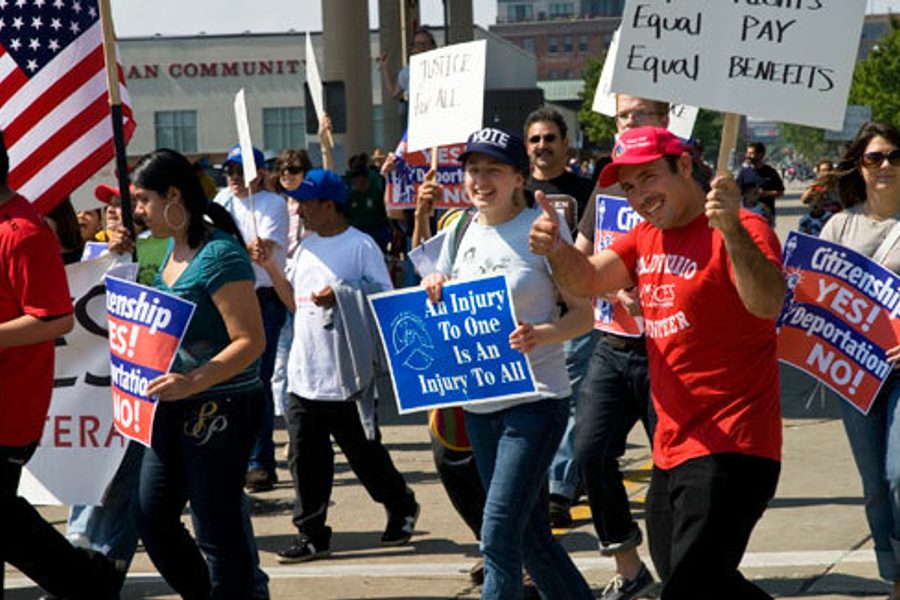
Under the influence of successively less articulate, less visionary, and less militant leaders at the top of the AFL-CIO (Phillip Green, George Meany, and Lane Kirkland), America’s organized labor movement increasingly lost its ability to inspire virtually anyone.
Allies? We don’t need no stinking allies.
Reaching the public through the media? We don’t negotiate through newspapers.
Jobs going to the South, Mexico and China? Those people are too ignorant and unskilled, and the companies will bring those jobs back. Just you wait.
For decades marked by this kind of complacency and arrogance, labor had no enobling rhetoric, no rallying cries, and no symbols of the courage of working people. (I recall a huge 1980 rally with tens of thousands of unionists present; I saw a single poster from the 1977 movie “Norma Rae” as the only visual expression of what labor stood for.)
That’s why Milwaukee’s Labor Day march was such a remarkably uplifting event.
There were thousands upon thousands of union members in the city yesterday, wearing bright t-shirts representing their union contingent. Many carried signs calling for a public option for health care.
There was a powerful sense of pride in being part of a vibrant, active, and massive movement that represents working people of all races and is on the side of economic and social justice.
The march also included community groups like Voces de la Frontera, representing Latino immigrant workers, Growing Power (an activist food-growing project), a marching band from a local middle school, stiltwalkers, dancers, and giant puppets mocking corporate greed. It was a stream of colorful, inclusive, and creative images.
Yet at this particular moment, the labor movement faces a daunting set of challenges. As former mineworker Richard Trumka gets ready to become AFL-CIO president on Sept. 16, he will confront a set of urgent and massive challenges:
- The future of healthcare reform is now balanced on a razor’s edge. IF President Obama continues to be stuck in reverse in his Wednesday night address, we could wind up with him proposing healthcare reform that would actually reinforce the power of insurers and drug companies. A Medicare-based public option must be the minimum condition for a reform that labor and progressives can support.
- Trumka will have to follow through – against the counsel of some in labor and the entire Democratic Establishment – on his threat to bite back against the Blue Dog Democrats selling us out on healthcare refrom.
- Labor’s approval rating with the public has dropped ten points. According to a Sept. 3 Gallup poll “fewer than half of Americans – 48%, an all-time low – approve of labor unions, down from 59% a year ago to 49% in recent months.” Paradoxically, 66% of Americans believe that unions improve the lives of working people. It’s unclear what caused this downturn, but labor has suffered quite a beating in both the mainstream media and the right-wing echo machine over the Employee Free Choice Act, which is barely understood by many of labor’s liberal allies.
- The national unemployment rate of 9.7% is cause for continuing alarm, as industrial communities from my hometown of Racine, Wisc. to Detroit are up to the 17%-22% range. Worse, the continuing mass layoffs and outsourcing of jobs is chopping the legs out from under Obam’s stimulus package. As Moody’s Economy.com economist Mark Zandi warns, “Consumers just don’t have the firepower to go out and spend more. Unless businesses curtail their job cuts, the recovery could very well peter out.”
Thus, labor needs Obama to pressure Corporate America to halt the tide of layoffs and outsourcing that is highly unpopular with the public.
And workers seeking to counter the wave of plant closings and relocations are receiving far too little help from the national AFL-CIO in building alliances with their communities, which also stand to suffer hugely.
Unless local unions get considerable help developing clear messages and building grassroots coalitions, corporations will find it all too easy to relocate while blaming labor “intransigence” and further eroding labor’s public standing.
With Rich Trumka, labor will have a much more youthful, articulate, and militant face. He will need to hit the ground running.
But given the way labor is changing at the grassroots level as displayed in Milwaukee on Labor Day, he is likely to find a movement profoundly hungry for substantive action to challenge corporate power.








